
Germany - electric locomotive hauled trains of DB AG and DB Cargo

A Bombardier TRAXX locomotive of the first generation (class 146.1xx)
with a fitting rake of Bombardier double decker coaches. This is a very typical DB AG regional train in 2016.
Compare with the IC2 train shown on the title page of Germany. Photo at Muenster Hauptbahnhof 8.10.2016 by Ilkka Siissalo.
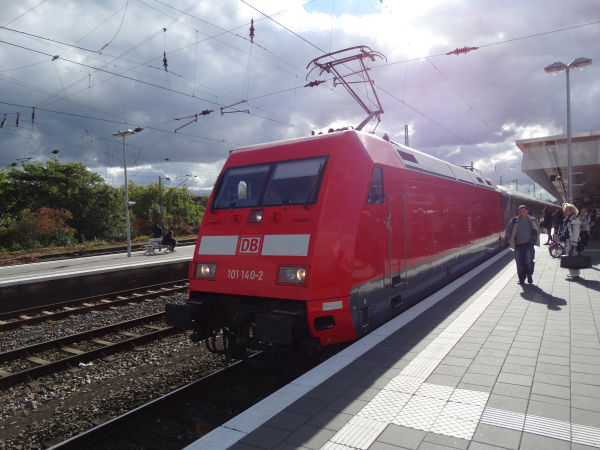
The Baureihe 101 is nowadays the most common long distance express and InterCity train locomotive of DB in Germany. The design is already
fairly old and preceeds all the current Bombardier and Siemens designs. These locomotives were built by ADtranz before it was integrated
into Bombardier. They were built in 145 copies in 1996-99. It is a single electric system (15 kV 16,7 Hz) locomotive. Its top
speed is 220 km/h and the power rating is 6400 kW. Picture at Münster Hauptbahnhof 8.10.2016 by Ilkka Siissalo.
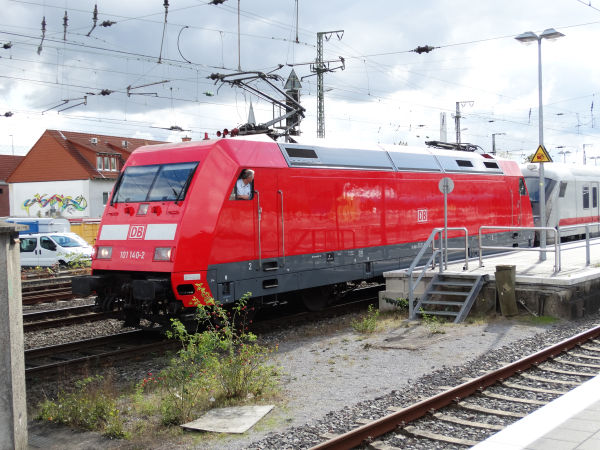
The same train as above. Note the first coach after the locomotive, which is an InterCity driving trailer. This was one of those
IC trains where there is a locomotive at both ends of the train and not just the usual push-pull operation with just one locomotive
and a driving trailer. The reason was extra wagons due to a very busy time. Picture at Münster Hauptbahnhof 8.10.2016 by Ilkka Siissalo.
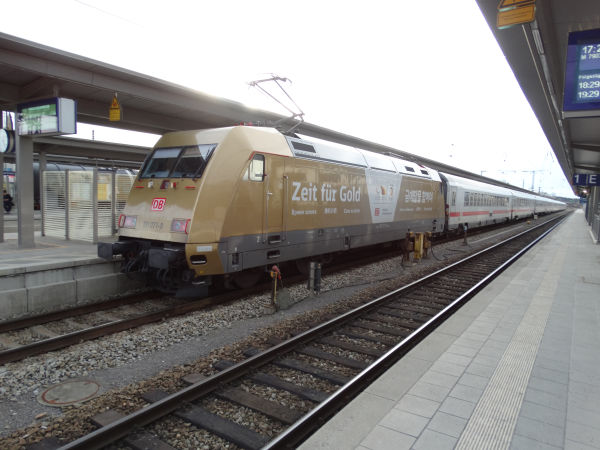
DB has nowadays a lot of locomotives totally covered by advertisement tapings. This one with the text Zeit für Gold (time for gold) was
avertising the 2018 winter olympic games and the fact that DB was one of the main sponsors of the German team there. This is a very normal
Br101 locomotive leading here an InterCity train.
Picture from Rosenheim 13.3.2018 by Ilkka Siissalo.
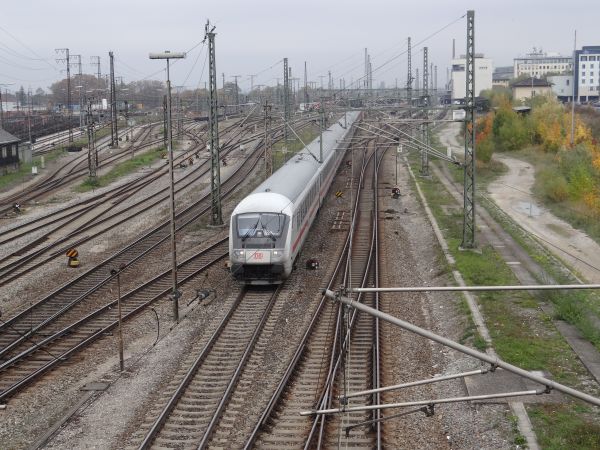
A very typical German InterCity train being pushed drivers cab coach first and locomotive last out of the Augsburg Hauptbahnhof
station towards München.
Picture from Augsburg 11.10.2015 by Ilkka Siissalo.

This is a very special train. For some time DB tried to establish a premium priced, specially silver painted luxury fast train between Hamburg
and Köln with a 220 km/h speed, almost no stops and with specially built luxurious coaches with a train attendant devoted to each coach.
It had the marketing name and logo of "Metropolitan". See
en.wikipedia.org/wiki/Metropolitan_(train). The operation lasted 1999 to December 2004 until DB gave up. Not enough people wanted to pay
a premium price for a service which was in no way better than the normal ICE services. Afterwards the coaches and
locomotives were painted in normal InterCity colours and taken into normal IC train use and later into ICE use. Today the two existing
ex-Metropolitan coach rakes are the only locomotive driven ICE trains in Germany.
This is one of the two ex-Metropolitan trains.
Look at the coaches: no door at the front on one side, it is painted like an IC coach, but actually it is derived from an InterCity Express
ICE 2 coach and now used in ICE traffic. The Br 101 locomotive is also no longer Metropolitan silver grey, but normal "verkehrsrot" red.
Picture from München Hauptbahnhof 13.9.2016 by Ilkka Siissalo.
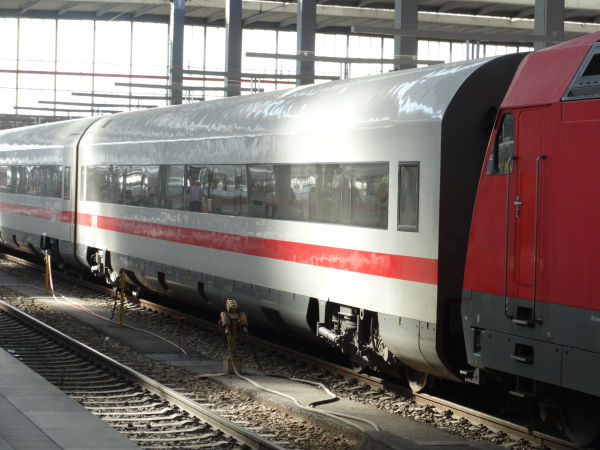
Another picture of the special ex-Metropolitan coaches. Pressure tight, fewer doors, derived from ICE 2 coaches, running as an ICE.
Picture from München Hauptbahnhof 13.9.2016 by Ilkka Siissalo.
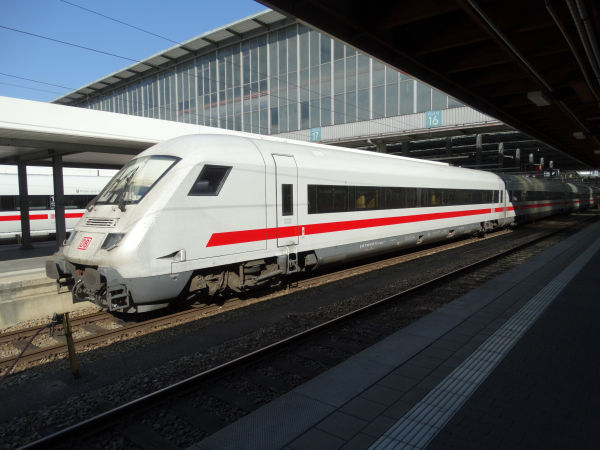
At the other end of the Metropolitan trains there were specifically built driving trailers, which are like modern crosses between a normal
InterCity train driving cab trailer wagon and an ICE wagon. But despite all the intention towards maximum comfort and modernity, these
specifically made Metropolitan coaches have their problems. The air conditioning for example is not strong enough and at times when the
outside temperature reaches +28C, these coaches have to be put aside out of use according to present regulations as the temperature inside
is no more tolerable. By the way, at the time when this picture was taken, the outside air temperature was +26C and everyone was sweating...
Picture from München Hauptbahnhof 13.9.2016 by Ilkka Siissalo.
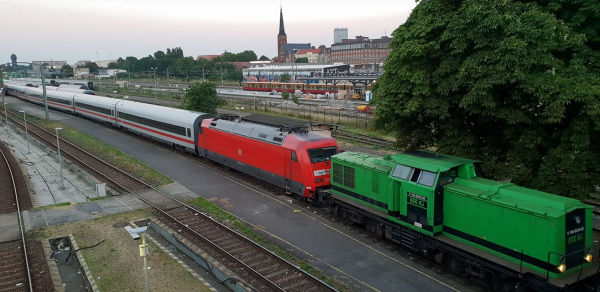
A view of one of the two existing former Metropolitan trains, now running as a locomotive driven ICE. Here the train is being pulled
into Berlin Ostbahnhof by a diesel shunter locomotive, a former East German V100 now owned by the company BUG, BUG Vermietungsgesellschaft
mbH, a locomotive leasing company.
Photo from near the Berlin Ostbahnhof station at 25.6.2018 by Risto Vormala.
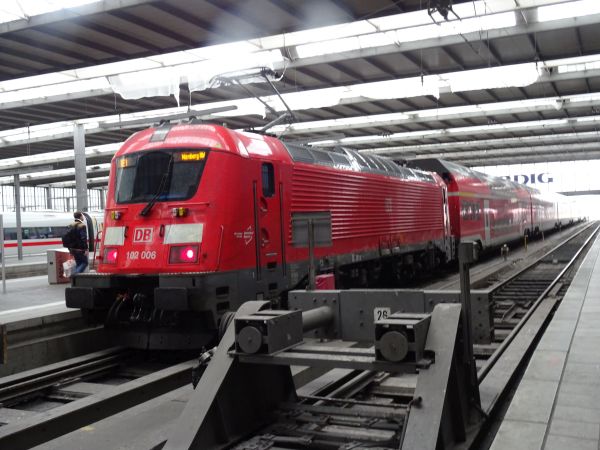
Br102 is a rare locomotive class as only six machines were delivered. Its story began some years back when DB needed new fast locomotives
for the München-Nürnberg-Express service, a.k.a Regionalexpress RE1. At that time DB was quite irritated by the inability of both Siemens
and Bombardier, its usual train builders, by the very slow pace with which they could get their new models officially accepted to run in Germany.
So this time they chose Škoda. This Br102 is essentially the same machine as the Czech Škoda type 109 "Zatopek", except that the Br102 can only
operate under the 15kV AC electric system whereas the Czech variant supports multiple voltages. But ordering from Škoda didn't make things
faster. It took several years before these machines got their official OK to start running. And now this is a real "Splittergattung" with
only 6 machines.
Picture from München Hauptbahnhof 15.10.2022 By Ilkka Siissalo.
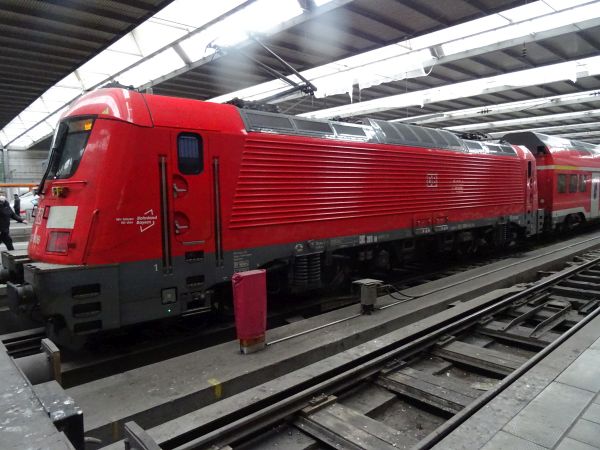
A closer look at the Škoda Br102.
Picture from München Hauptbahnhof 15.10.2022 by Ilkka Siissalo.
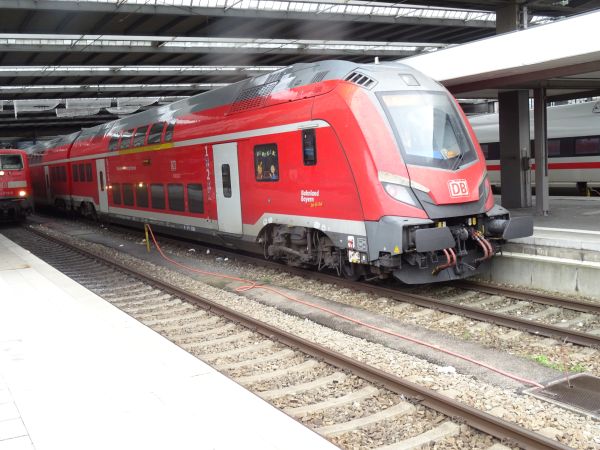
These Br102 locomotives operate together with their own sets of doubledecker coaches. They differ from standard doubledecker coaches for example
by their pressure tight doors. The RE1 line runs really fast between München and Nürnberg and passing trains in tunnels would otherwise cause
unpleasant noices at those speeds. This is the steering cab coach of one of these coach sets specifically designed for the München-Nürnberg
Express.
Picture from München Hauptbahnhof 14.10.2022 By Ilkka Siissalo.
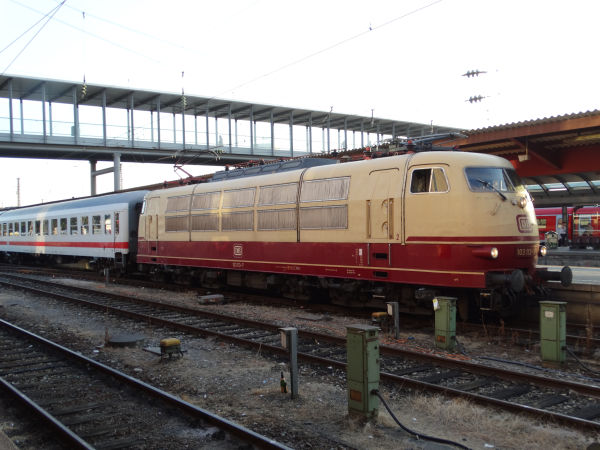
For a really long time the class 103, former E03, was the fastest, best and most beautiful of the German express train locomotives.
This one of them, no 103 113 was one of the last in regular passenger traffic, and in daily use in München to Ulm InterCity service
until late autumn 2016 when it suffered a major engine failure. The loco has since been preserved by DB Museum in Koblenz. Here it
has just arrived at Ulm 3.9.2016. Picture by Ilkka Siissalo.
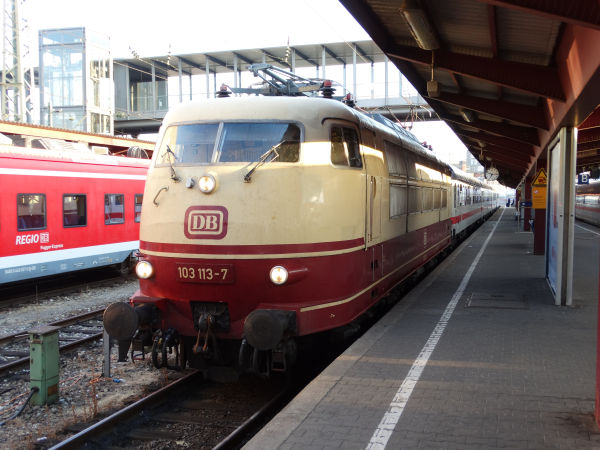
Another picture of the class 103 no. 113 in Ulm 3.9.2016 in its classic wine red and creme painting which these machines used to have
when they were new. Picture by Ilkka Siissalo.
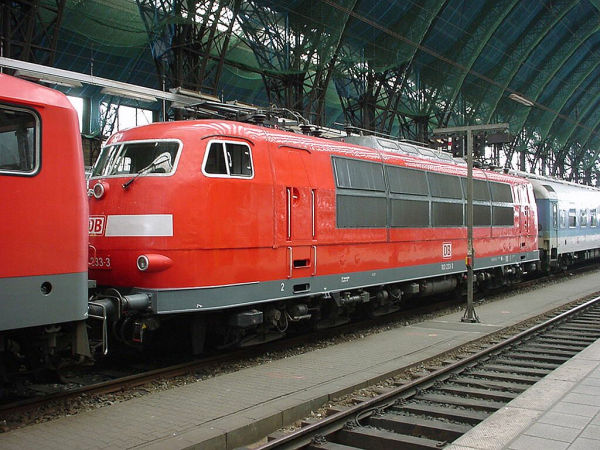
Only one Br 103 locomotive ever got painted in DB's newest "Verkehrsrot" red livery. This is the one, 103 233. The model railroad
company Roco paid for its special painting and then Roco published a small limited (and terribly expensive) series of H0 scale
models of it. Actually that livery suits the locomotive's design quite nicely, or what do you think?
Picture from Frankfurt Hbf 25.3.2002 by Ilkka Siissalo.
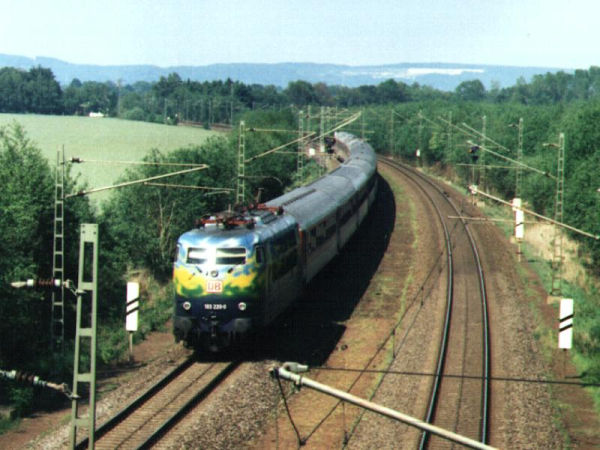
For a while DB had a subsidiary called DB Bahntouristik for tourist trains from Germany over the Alps to the Mediterranean area.
For that purpose one full train set and the locomotive of class 103 no.220 got a fairly odd painting scheme, with a light blue sky with
clouds, green and yellow in the middle and dark blue at the bottom.
Original file text: A machine with a very special painting is the 103 220-0
from the German railway DB. Between Osnabrück and Münster
this Intercity has passed the village Kattenvenne.
Photo taken at June 6th, 1996 by H.Pohlmann (from the University of Münster).

Before the long era of the Br 103, pictured above, being the most prestigeous German locomotive, there was the E10, later Br 110,
even later Br 115. This locomotive type was built as part of the 1950s "Universallokomotiven" program and it shared many parts
with for example Br 140, Br 141 and Br 150 which were part of this family. Initially it was known as E10 and it was the locomotive
for all the fastest, best trains of the country. E10 existed in two variants. The original variant, "Kasten-E10" had a flat face,
whereas the bit later constructed "Bügelfalten-E10" had a slight bend in the middle of its front and it looked slightly more modern
and aerodynamic.
Here we see one of the once famous "Bügelfalten-E10", here as Br 110 and no more dark blue as they used to be in their heyday times,
but in the now regular "Verkehrsrot" red paintings and now hauling a very old rake of formerly famous 1960s "Silberling" coaches, which
are no more silver grey like they used to be, but in the 1980s "minttürkis" paintings. That's what the elderly often get to do: haul
the less heavy ones as long as you can. Comment dated in 2022: Now all the Silberling coaches are gone and almost all of these
locomotives are gone too...)
Picture from Frankfurt Hauptbahnhof 25.3.2002 by Ilkka Siissalo.
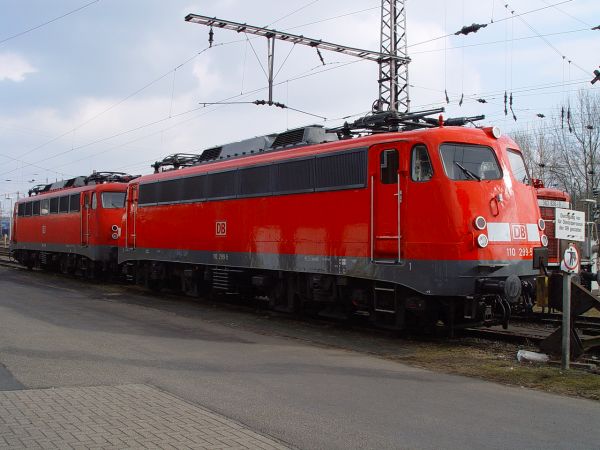
Two of the "Bügelfalten-E10" locomotives, then marked Br110 in a fresh painting. The word Bügelfalten means that somebody has taken a
clothes ironing iron and straightened their faces like one would do to men's trousers :-)
Picture from Osnabrück 1.3.2003 by Ilkka Siissalo.

A closer look at one of the two locomotives shown in the upper picture. This is the one on the left. Notice that they are not completely
identical: one has a window in the middle, the other one just a ventilation grille.
Picture from Osnabrück 1.3.2003 by Ilkka Siissalo.
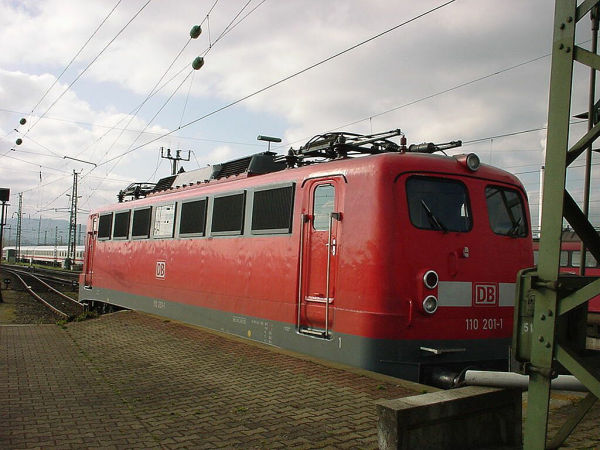
This is the "Kasten-E10", same locomotive as above, but with the original totally flat face.
Picture from Basel Badische Bahnhof in Switzerland 25.3.2002 by Ilkka Siissalo.

Here we see a similar Kasten-E10 version of the Br 110 but this one is still wearing the previous DB livery called orientrot
(oriental red).
Picture from München Hauptbahnhof (Munich main station) 14.6.2002 by Ilkka Siissalo.
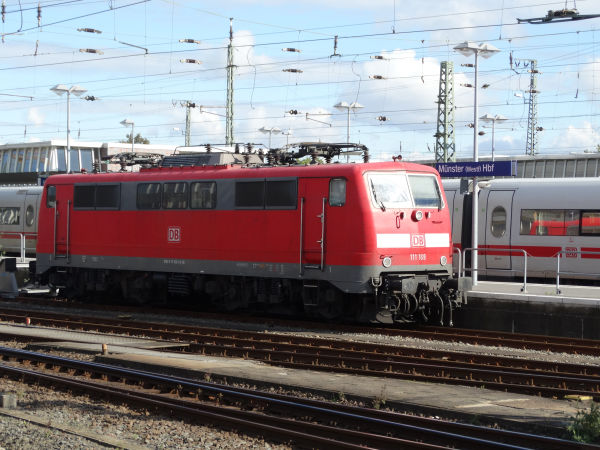
DB class 111 is from the 1970s. It was originally used in both express and regional trains, but nowadays you can see it with
few exceptions in front of regional trains only, most often with doubledecker coaches.
Picture from Münster Hauptbahnhof 8.10.2016 by Ilkka Siissalo.
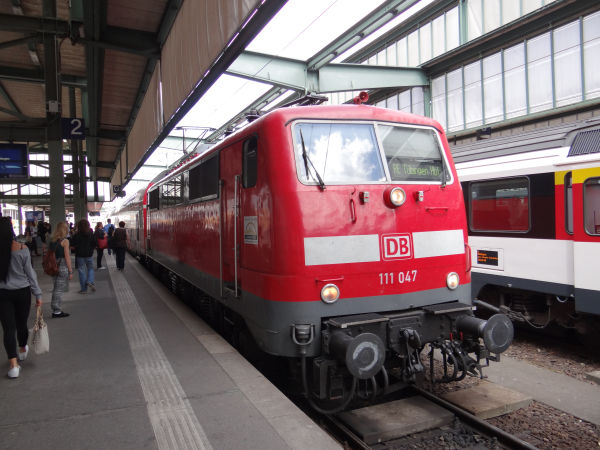
Another class 111 locomotive, here ready to pull a doubledecker service out of Stuttgart. Picture at Stuttgart Hauptbahnhof 8.7.2015
by Ilkka Siissalo.

Most of the Br 111 locomotives were delivered in this "Türkis" livery, which was first taken in use in the 1970s. Many of the locomotives,
just like this one, carried these colours until the end of the 1990s or even well into the 2000s.
The coaches which can barely be seen behind the locomotive are of the type "Modus". They were modernised or even totally rebuilt communist
time DDR East German Halberstädter coaches, out of which only the underparts were used, and which had totally new and modern chassises.
As of 2019 even of these rebuilt Modus coaches none are left. Even though the upperparts were modern, the undercarriages were still of the
old communist time DDR style and were not satisfactory. Presently the remaining Modus coaches are in Gabon in Africa.
Picture from Frankfurt Hauptbahnhof 25.3.2002 by Ilkka Siissalo.

Some of the Br 111 locomotives were used in the Düsseldorf area S-Bahn traffic and got there the grey and orange S-Bahn livery which was
first created in the 1980s. Here is still one of those locomotives carrying the old orange livery, although here already in new services
in Frankfurt.
Picture from Frankfurt Hauptbahnhof 25.3.2002 by Ilkka Siissalo.
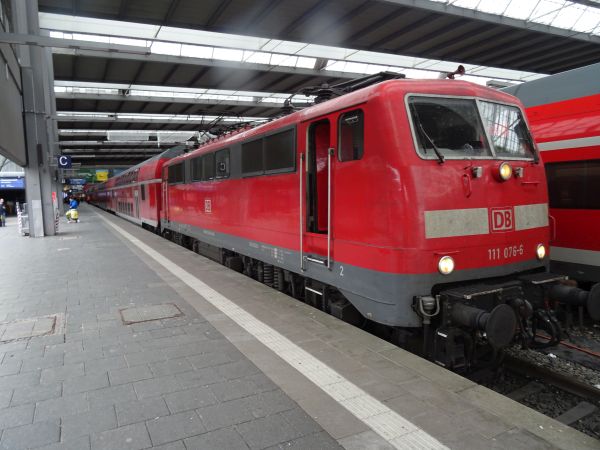
Br111 locomotives are already getting old, but they are still going strong. They are nowadays most often seen in front of doubledecker
coaches built by Bombardier.
Picture from München Hauptbahnhof 14.10.2022 by Ilkka Siissalo.
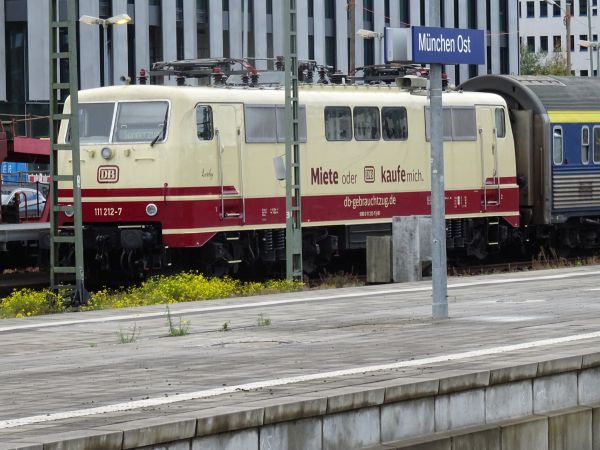
DB doesn't any more need all the Br111 locomotives it has. This one, named "Loreley", has been painted in what is supposed to look like a
retro-Trans-Europ-Express locomotive. In real life no Br111 machine ever carried this livery during those years when TEE trains were running.
The large text on the side says "rent me or buy me" and the machine is offered for sale at the internet site www.db-gebrauchtzug.de (DB
used trains site).
Picture from München Ostbahnhof 15.10.2022 by Ilkka Siissalo.
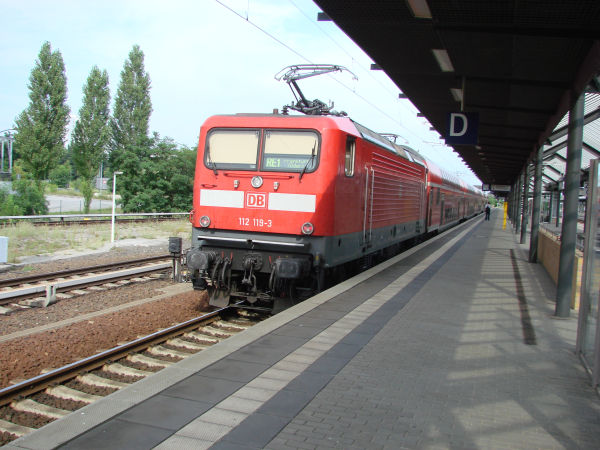
This is the class 112. It was known as class 212 by the East German Railways DR, even though only a prototype was produced before the
German reunification. It is the faster variant of the much more common class 143 pictured
below, intended for fast express trains. It looks almost identical to the Br 143, except for the front lamps.
Picture from Potsdam station 21.7.2007 by Ilkka Siissalo.
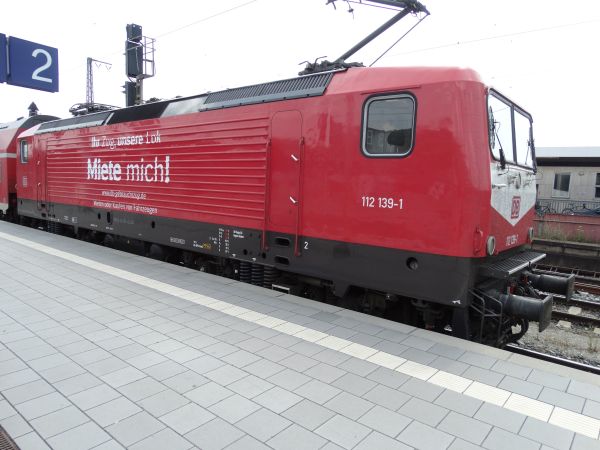
...and this is another train from DB Gebrauchtzug, the part of the company which sells and rents old trains and locomotives which DB doesn't
feel like needing any more. Typical of DB Gebrauchtzug is also that they paint these locomotives that they are offering in old "retro" liveries.
Also this Br 112 looks almost like it has been when they were new. Here we see this Br112 in Würzburg leading a very DDR style train of WFL,
Werner Franz Logistik. This was a replacement train for GoAhead, a private operator which still was missing some of their brand new Stadler FLIRT
units and therefore still needed to rent replacement trains. In this case the replacement train was pure "ostalgy", a completely DDR style old communist
East German train. Though honestly, DDR never used these Br112 locomotives. Only one prototype existed at the time when the two German states
reunited.
Picture from Würzburg 10.7.2023 by Ilkka Siissalo.
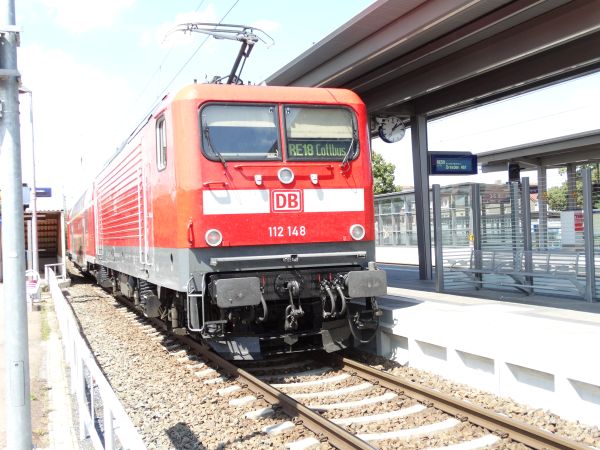
Another view of a class Br112 locomotive, here in front of a regional express train.
Picture from Coswig 16.7.2018 by Ilkka Siissalo.
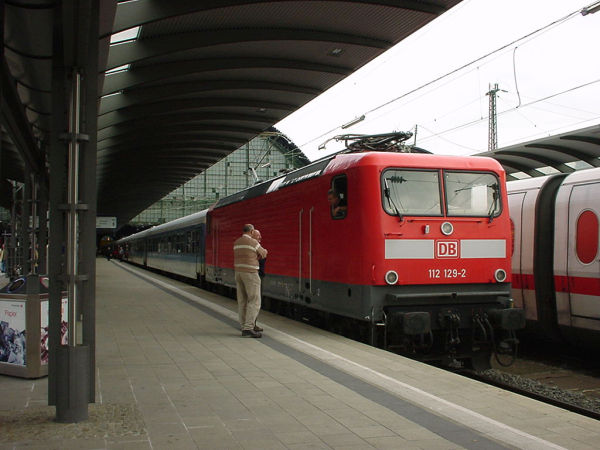
A Br 112 locomotive in front of an InterRegio train just about to leave towards Stralsund. The Br 112 looks almost the same
as the Br 143 pictured below, but 112 is the faster express train variant. At a quick glance the lamps are the first difference
which is easy to spot.
Picture from Frankfurt Hauptbahnhof 25.3.2002 by Ilkka Siissalo.
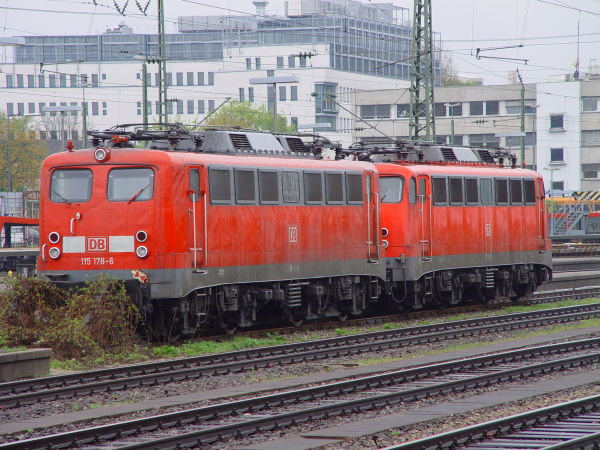
Two of the class 115, former type E10 / Br 110 locomotives at München Ostbahnhof. The one in the front is the E10 variant with the flat face.
The one in the back is one of the Bügelfalten-E10, "ironing iron" models. The difference is very slight, but if you look really closely
at the locomotive at the back, it has a small extra window between the driver's door and the windscreen. Compare also with the
picture above. Picture at München Ostbahnhof 29.4.2006 by Ilkka Siissalo.

This is a rake of Spanish-made Talgo train wagons, a so called Hotel Train of DB AutoZug. These were permanently fixed compositions
used as nighttime trains on long runs, such as the München to Berlin route. These were typically pulled by one of the Br115
locomotives pictured above.
Picture from München Ostbahnhof 14.6.2002 by Ilkka Siissalo.
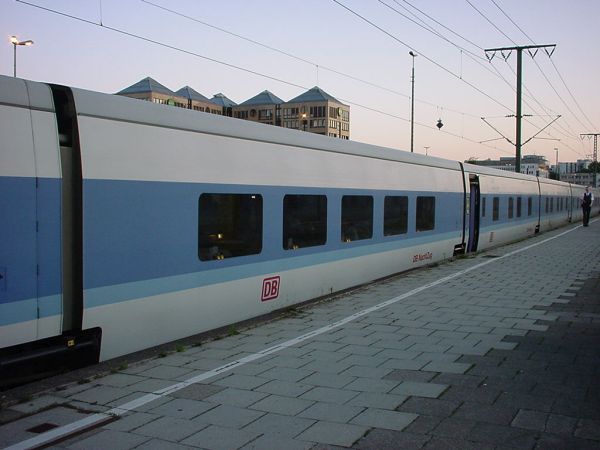
Side view of one of the Talgo Hotel train coaches. The coaches were shorter than those of normal trains and they had no bogies but
just individual axles fitted right between two coaches. It was not possible to leave out coaches or otherwise modify these compositions
during normal operations.
Picture from München Ostbahnhof 14.6.2002 by Ilkka Siissalo.
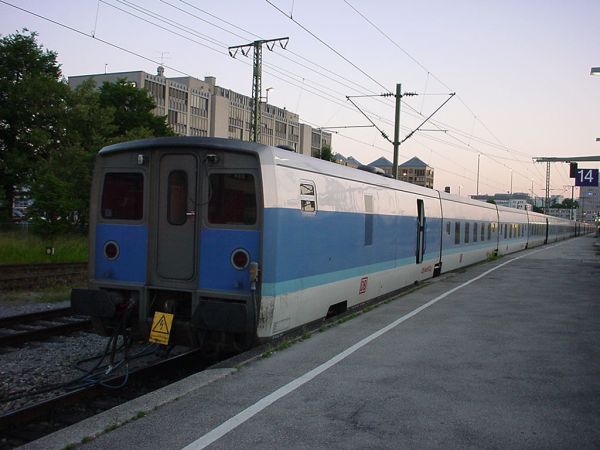
A typical Talgo Hotel train was a really long composition. DB AutoZug took the first ones in use in 1994 and the last ones were
decommissioned in 2009.
Picture from München Ostbahnhof 14.6.2002 by Ilkka Siissalo.
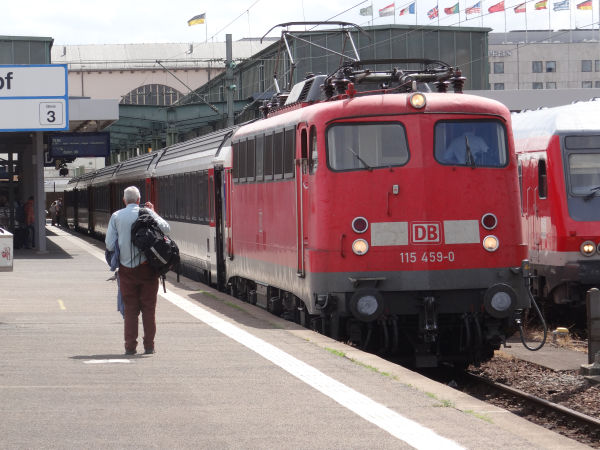
The Stuttgart - Zürich EC trains were the last ones to use the classic 1950s/1960s locomotives in regular, prime EuroCity services. This is
a Br 115, former Br 110, still former E10, which was one of the 1950s "Einheitslokomotiven". The class E 10 / Br 110 existed in two versions,
one with the flat "face" as typical of all the Einheitslokomotiven, but one also - this one - with a slightly modified, a bit more aerodynamic
"face". The nickname of these was Bügelfalten-E10, a notion to a laundry ironing iron. These used to be the top of the top, finest of the fine,
anno Domini around 1962 or so. Here one of them is still alive and moving and about to haul an international EuroCity with Swiss SBB coaches
towards Switzerland. Just like in the 1960s. But you wouldn't expect this anymore in 2015. Regular use of these locomotives on this line ended
in December of the same year. One year later it would already have been a "Wow" to see one of these moving, let alone at the front of a
prestigious cross border EuroCity. Feel the waves of history... :-) As of 2019, only two locomotives are still active with DB, but their future
is extremely uncertain.
Picture from Stuttgart Hauptbahnhof 8.7.2015 by Ilkka Siissalo

This is the DB class 120. It was Germany's first really modern high-speed express train locomotive. It looks still quite modern,
although the design is already from the 1970s. They were built in two series 1979-1989, in total 65 of them, by a consortium of the
companies BBC, Henschel, Krauss-Maffei and Krupp. It works only on 15 kV AC. Top speed is 200 km/h. This one is from the second series
built 1987-89. Picture at Karlsruhe Hauptbahnhof 8.7.2015 by Ilkka Siissalo.
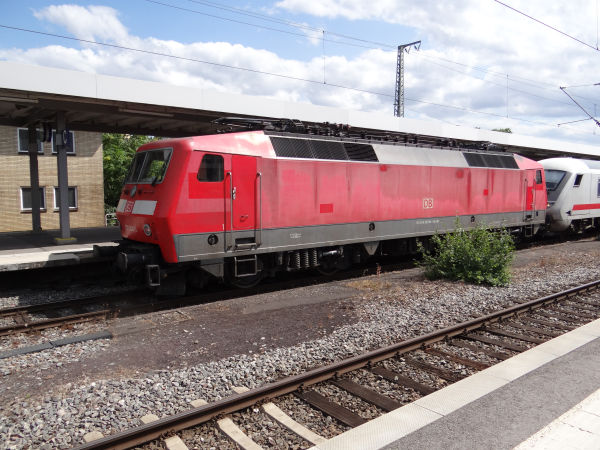
Another class 120 locomotive, this time the no. 104. It looks like it definitely would need a new painting. Picture at Karlsruhe
Hauptbahnhof 8.7.2015 by Ilkka Siissalo.
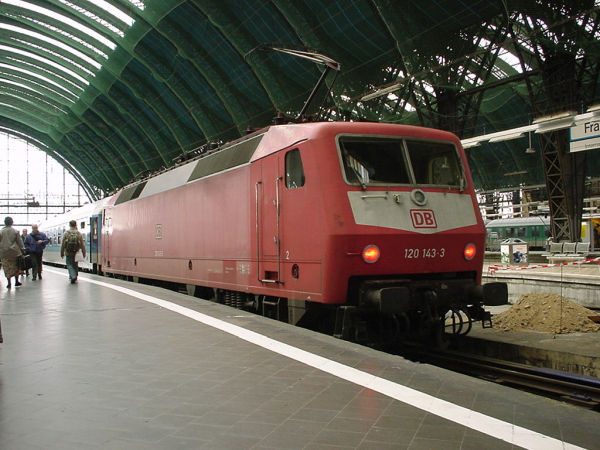
Another class 120 locomotive, but in the older so called Orientrot livery and in front of a blue and white rake of InterRegio
train coaches. The train class InterRegio or IR does not exist any more.
Picture from Frankfurt Haupbahnhof 25.3.2002 by Ilkka Siissalo.
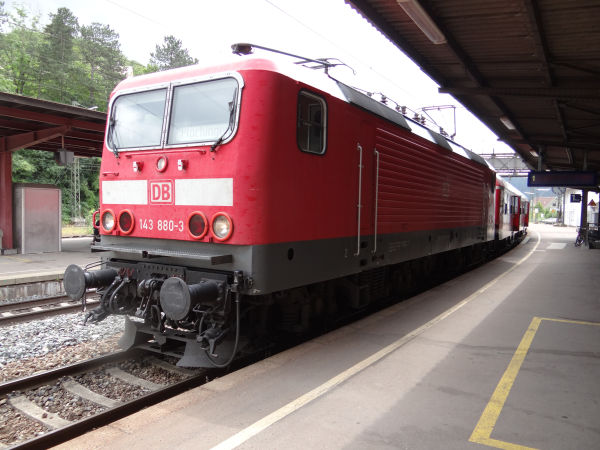
Baureihe 143, earlier 243 of the DR of ex-DDR, was the last one of communist East Germany's locomotives that was built in bigger
numbers. It was in many ways superior to most electric locomotives that western DB was using at the time of the reunification of
the German states. Beginning in 1990, the eastern DR leased a large number of these to DB, and after the reunification the production
in Hennigsdorf in former East Germany was continued for both DR and DB as a somewhat upgraded and faster variant, now known as classes
112 and 114. There were political motives as well, but in the west a large share of the existing locomotives were still from the
"Einheitslokomotiven" group of locomotives from the 1950s, and these machines were a welcome and much needed refreshment to DB's
rolling stock. They have been used especially in regional traffic and they very quickly pushed aside for example the 1950s class
Br 141. In the first years of this millennium, DB planned to upgrade a big number of 143 locomotives to class 114 to allow the
locomotives to replace class 111 on services where 160 km/h maximum speed was required. However, only two locomotives were converted
and even these were never allowed to run faster than 120 km/h.
Picture of a Br 143 at Geislingen (Steige) station 9.7.2015 by Ilkka Siissalo
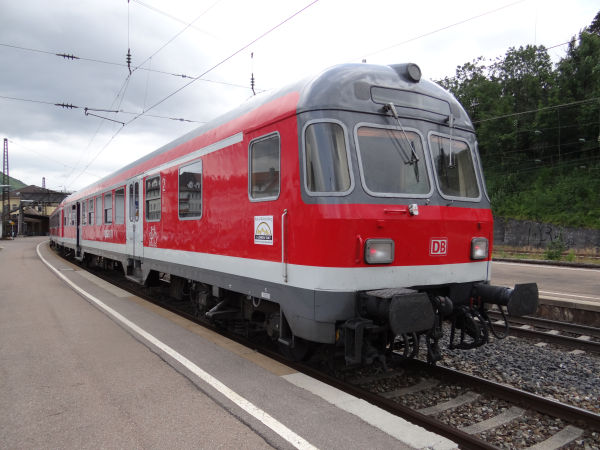
This is the other end of the same train as the Br 143 locomotive above. This is a steering cab wagon known as the "Karlsruher Kopf"
(head of Karlsruhe). The coaches are of the very famous n-Wagen or "Silberling" series from the 1960s and since the beginning of 1960s,
there were steering cabs built in them for push-pull operation. The very first driving trailers were not satisfactory however, with too small
spaces for the driver (They had the nickname of "Hasenkasten", rabbit cages) and they were quickly rebuilt with proper driving trailer cabs.
The two main types of cabs are known by their places of origin, the cities of Karlsruhe and Wittenberg.
The use of these Karlsruher steering cab coaches ended in December 2018.
Photo at Geislingen (Steige) station 8.7.2015 by Ilkka Siissalo.
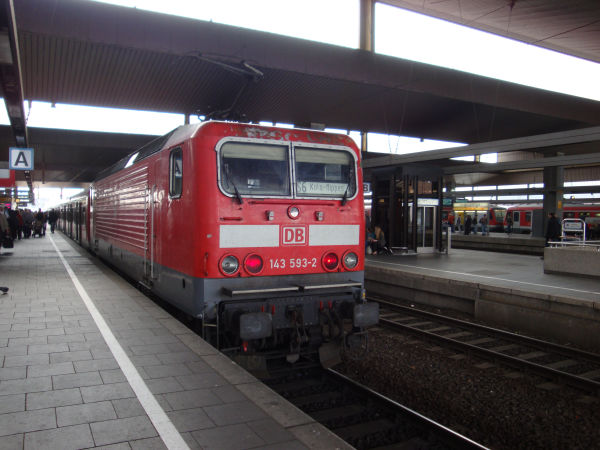
The ex-DDR class 143 has been a permanent part of regional passenger traffic of the Ruhr region of western Germany since 1990 when
the first locomotives were leased there from DR of East Germany. They have been used with S-Bahn local commuter train coaches of
the so called x-Wagen class since the beginning of the 1990s. In recent years they have been gradually pushed out of service,
especially by the newer EMUs of the class 422. Service in Ruhr region with x-Wagen will end in December 2019.
Picture from the Düsseldorf Hauptbahnhof 7.5.2009 by Sanna Siissalo.
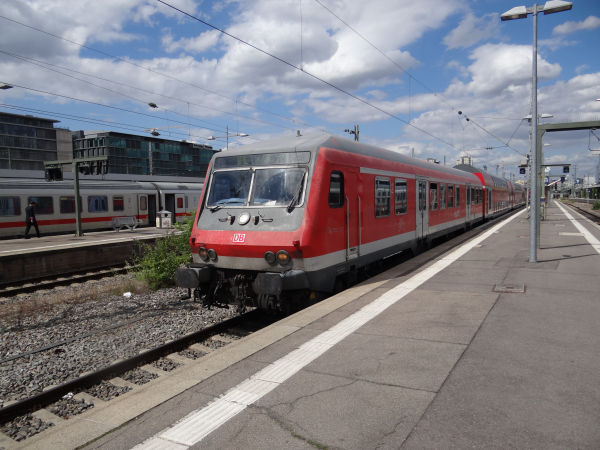
Compare with the picture above. This is the steering cab coach of the n-Wagen or Silberling wagons with the so called Wittenberg head.
Picture from Karlsruhe Hauptbahnhof 8.7.2015 by Ilkka Siissalo. (Sorry, this must be confusing to show a Wittenberg and not a Karlsruhe
cab precisely in Karlsruhe ;-)
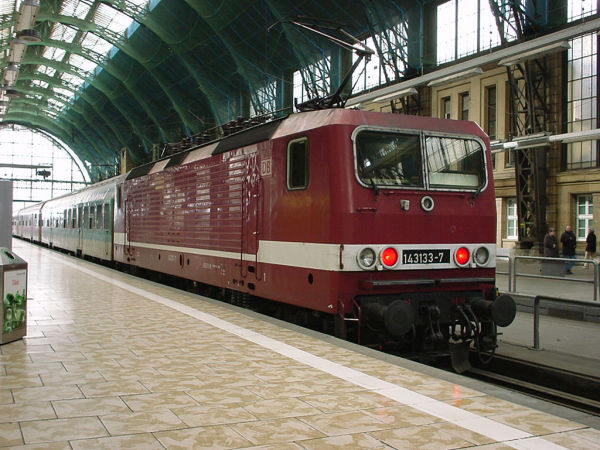
This is the original livery of the Br 143 locomotives. This wine red scheme is the one that was used by the communist DDR's DR
when these locomotives were still called Br 243. This one has gotten new DB stickers and its number at the front has been haphazardly
changed to the western Br 143, but other than that, it still is in its original style. Quite nice looking actually.
Picture from Frankfurt Hbf 25.3.2002 by Ilkka Siissalo.
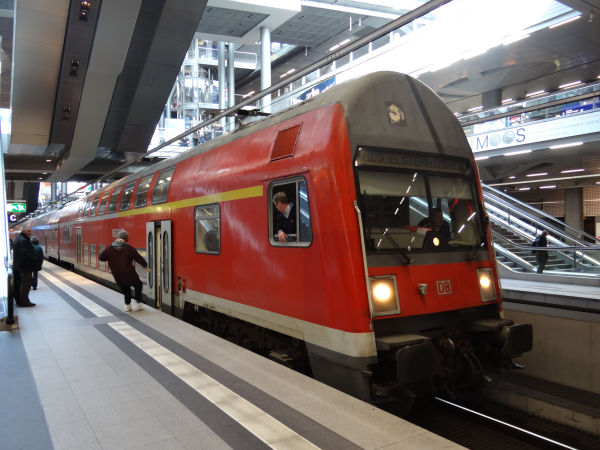
A young guy is desperately trying to catch the leaving RE5 train to Elsterwerda. This is an old DDR designed 2nd generation
double decker steering cab wagon, built in communist East Germany since 1988. At the other end of the train was a pushing
Br 143 locomotive, that also ex-DDR. Picture from Berlin Hauptbahnhof 4.3.2016 by Ilkka Siissalo.
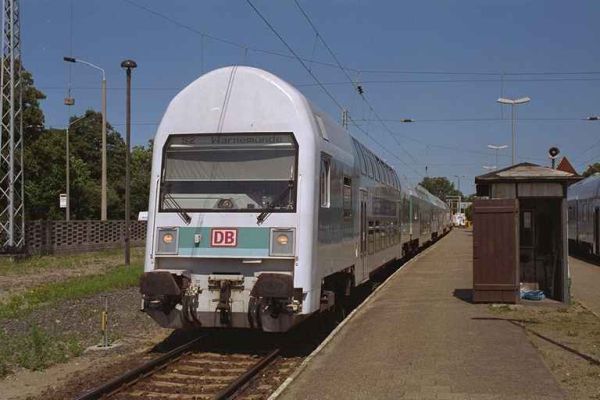
This is how the same formerly East German DR steering cab coaches used to look like soon after the reunification of the two German
states. These coaches had already been repainted into the DB's that time typical local traffic colours of mint green and light grey.
Picture from Warnemünde 27.7.1995 by Erik Hjelme.
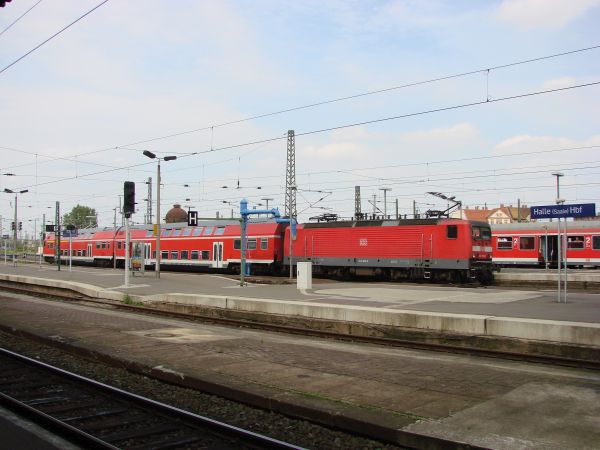
A rather typical local train from the former East Germany during early years of the new century. A Br143 locomotive and two modernised,
but already by then rather old double-decker coaches. These trains were quite an improvement over the old communist time trains, but
they were still lacking any kind of air conditioning.
Picture from Halle 21.7.2007 by Ilkka Siissalo.
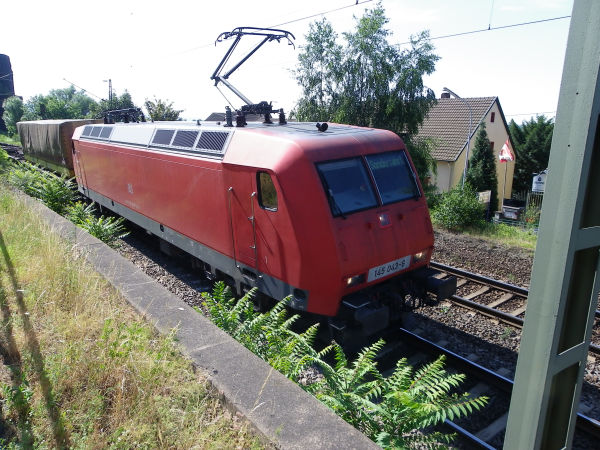
The DB class 145 is the very first generation of what later became known as the TRAXX family of locomotives built by Bombardier.
At the time when these were new, they were intended to be slightly weaker, but markedly cheaper basic cargo locomotives than the key
competitor Siemens' class 152 locomotives. Br 145 soon became a massive commercial success and TRAXX locomotives continue to be sold
even today in large numbers in many countries. In year 2000 a trial was made to see if the class 145 would be good for passenger traffic
as well. Some 145s got a display in their windscreens to show where the train is going and the necessary automation for opening and shutting
passenger coach doors. This one is one of those individuals - that is easy to see from the display panel at the front window with the
text "Sonderfahrt". (No, it's not going to a place called Sonderfahrt. Sonderfahrt means special service.) The trial was a success
and led later to the creation of class Br 146, the TRAXX passenger train variant.
Picture at Erpel by the Rhein river 8.7.2010 by Ilkka Siissalo.
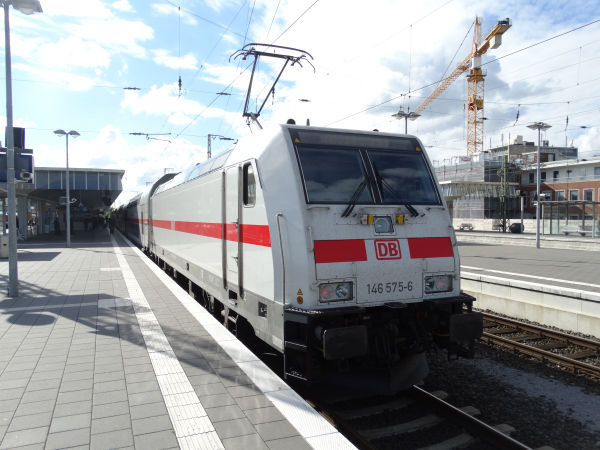
DB class 146 is the passenger train variant of Bombardier's TRAXX family of locomotives. This one is of the subclass 146.500
intended for faster InterCity train use and painted white according to the new IC2 train colouring scheme.
The initial "basic" TRAXX was the class 145, a simple, but cheap cargo locomotive. Some of those were tried in passenger traffic
and found out to be suitable. Out of that developed the class 146 for passenger trains. The most notable outer difference
between the cargo variant 145 and the passenger train variant 146 is the LED panel on top of the windscreen showing the train's end station
in the class 146 locomotives.
Picture from Münster Hauptbahnhof 8.10.2016 by Ilkka Siissalo.
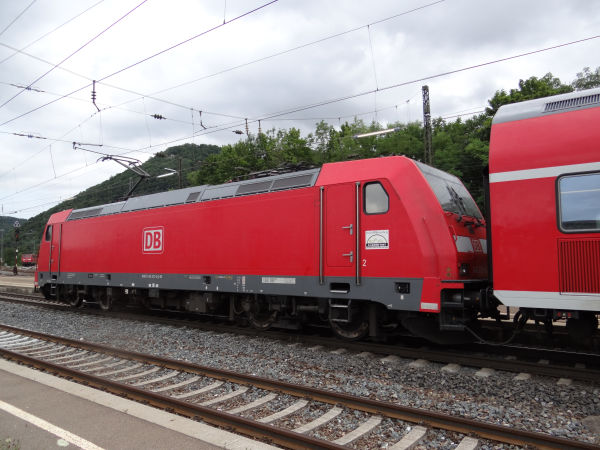
This is the second generation TRAXX passenger train locomotive of the Br 146.2xx class. It is almost identical with the machine shown
above, but used with regional trains.
Picture from Geislingen (Steige) station 8.7.2015 by Ilkka Siissalo.
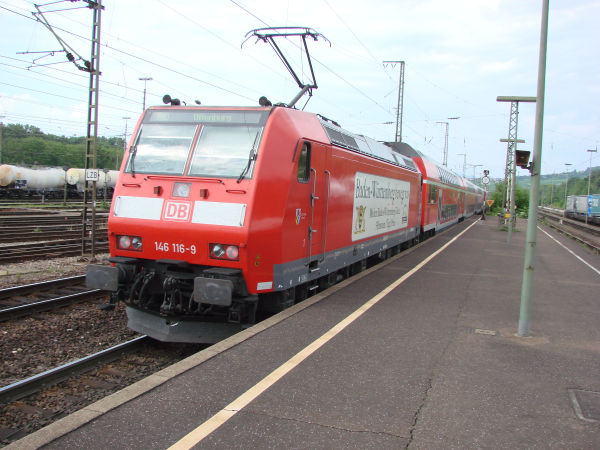
This locomotive is of the class 146.1xx. It is a first generation Bombardier TRAXX passenger train variant. One has to look at the front
really close to notice a difference with the later 146.2xx and 146.5xx locomotives, but the shape is slightly different. Photo from
Weil am Rhein station 17.7.2007 by Ilkka Siissalo.
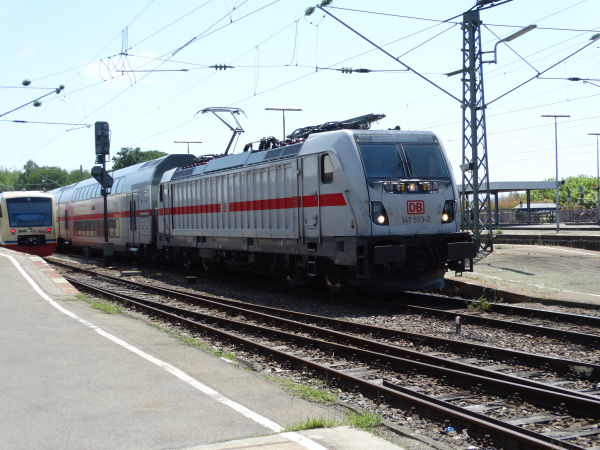
This is one of the very newest doubledecker InterCity trains of DB. The locomotive is a Bombardier TRAXX 3rd generation Br147.500, specifically
designed for these doubledecker IC trains. DB plans to use this kind of compositions also in traffic across the border to Zürich in Switzerland,
but at least at the time when this photo was taken, DB did not yet have the permission to use these locomotives in the Swiss network.
Picture from Radolfzell 4.7.2019 by Ilkka Siissalo.
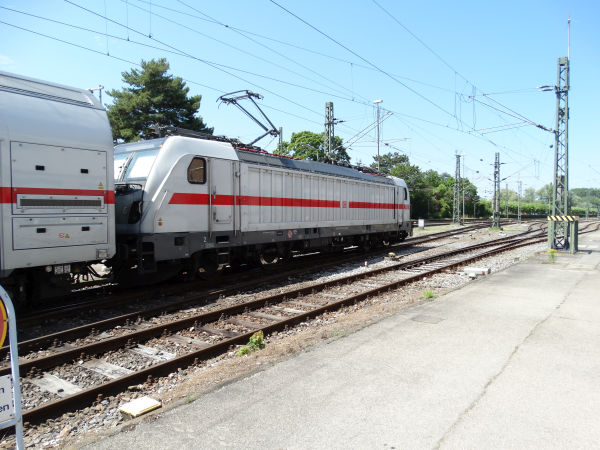
The same class 147.500 locomotive as above, seen from its side.
Picture from Radolfzell 4.7.2019 by Ilkka Siissalo.
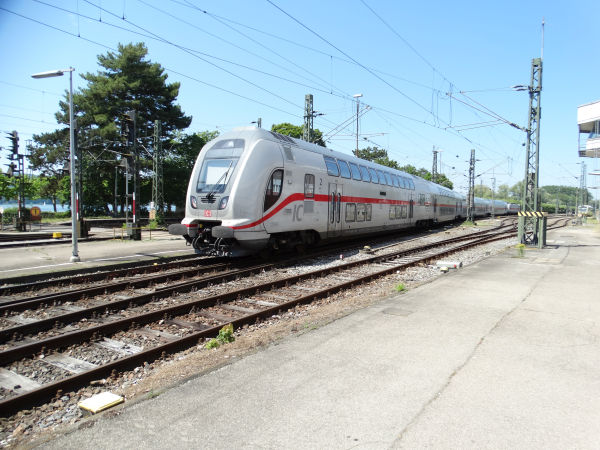
The other end of the same train as shown above. Bombardier's newest steering cab coaches are quite nice looking.
Picture from Radolfzell 4.7.2019 by Ilkka Siissalo.
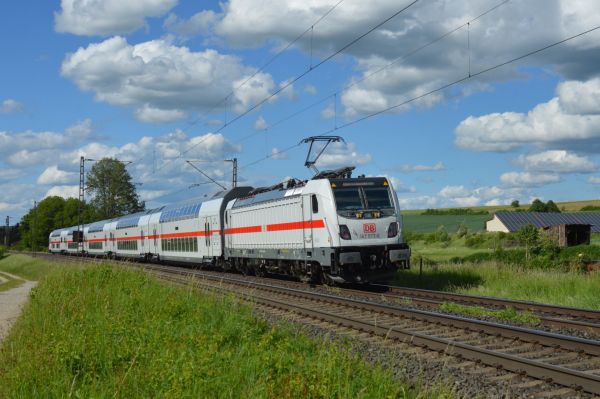
A typical new InterCity 2 in full speed somewhere down the line. A Bombardier TRAXX of the newest generation, Br 147.500, is pushing
a rake of five doubledecker coaches. These are fixed sets with always five coaches.
Picture by Steve Jordan 22.6.2022.
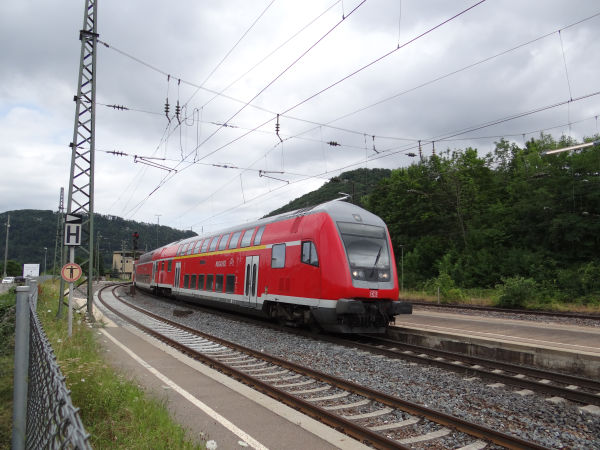
This is the 4th generation of Bombardier double decker steering cab wagons. These one can often see at the other end of trains with locomotives
just like the one above. Picture at Geislingen (Steige) station 8.7.2015 by Ilkka Siissalo.
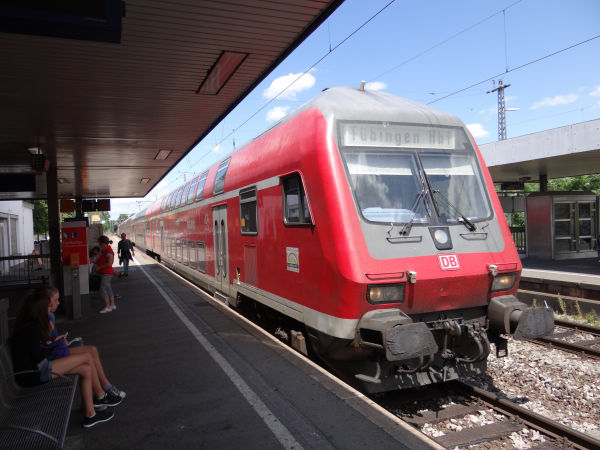
This is the 3rd generation of Bombardier double decker steering wagons, type DABpbzfa, which quite a lot resembles the "Wittenberger"
steering cab wagons of older n-Wagen or Silberling coach trains (see above), but is just a double decker. This also is a fairly common sight
with push-pull trains in southern Germany with DB locomotives of the type Br 146 or Br 111. Photo at Nürtingen station 8.7.2015 by
Ilkka Siissalo.
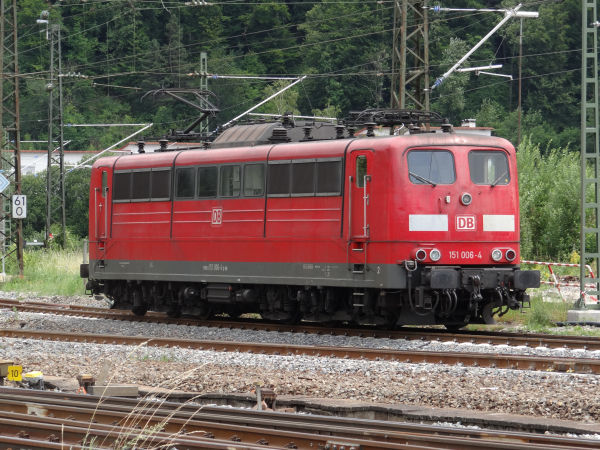
In the 1950s emerged a series of West German locomotives by the name of Einheitslokomotiven, unified locomotives. They all look pretty much
the same. Br 140 was the cargo variant, Br 141 regional passenger train variant, Br 110 express train variant, Br 112 (reclassed as Br 113
after German reunification) fast express train variant for services with 160 km/h, Br 139 the variant with an electric brake for mountainous
routes and Br 150 the six axle heavy cargo variant. In 2005 the Br 115 emerged as well, this was the same as Br 110 but dedicated for night
and long distance trains when majority of Br 110 had been moved to regional services. This machine in the picture is a Br 151, which is a
further development of Br 150 and which was intended to replace it. It was built not in the fifties, but in 1972-78, but still with the same
basic design. It is a six axle heavy cargo locomotive delivered in 170 copies. It produces 6288 kW of power. Some have been scrapped, a
great majority have been sold, but locomotives that are leased back from Railpool leasing company still run on DB Cargo services as of 2019.
Here we see one Br 151 waiting at Geislingen. There is a really steep uphill slope called Geislinger Steige and some of the more heavy trains
need another extra locomotive at the end to push them uphill. Therefore always one or two Br 151 machines are kept there waiting on duty.
Photo from Geislingen 8.7.2015 by Ilkka Siissalo.
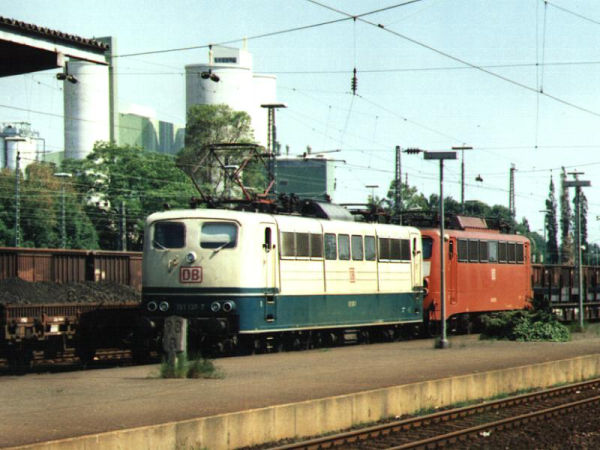
This is how the class 151 machines looked like in the 1970s. A Br 151 in the blue and creme seventies painting scheme and a class
140 four axle Einheitslokomotive in the so called oriental red painting scheme of the 1980s.
A heavy freight train is passing the station of the German town Lengerich. The 151 137-7 has the classic blue/beige painting. The
second loco of the type 140 is in the "Orientrot" red outfit. Photo taken at June 6th, 1996 by H.Pohlmann.
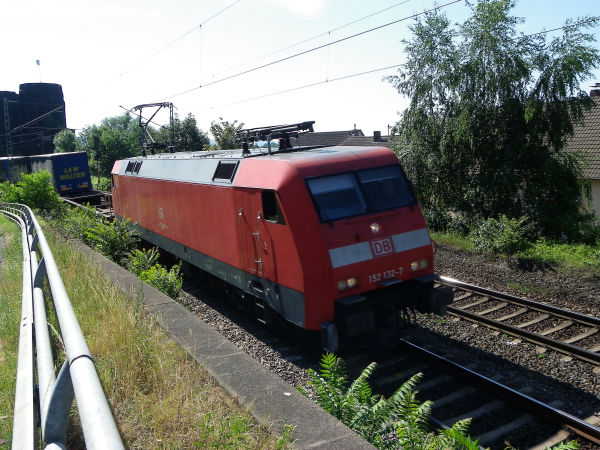
This is a cargo locomotive of the DB class 152. It looks like a Bombardier TRAXX, but it is not. This is an older type still from
those times when Siemens and Adtranz, later Bombardier, still worked together as a consortium and the model is derived from Siemens'
so called EuroSprinter platform. Bombardier later made a similar, but simplified and cheaper competing model, the Br 145, which later
became the forefather of the TRAXX family. The weakness of Br 152 was that it never got a permission to run in Austria as it was deemed
too desastrous for rails in Austria's curvy tracks. Nevertheless it was DB's first truly modern electric cargo locomotive in the 1990s.
Picture by Erpel by the river Rhein 8.7.2010 by Ilkka Siissalo.
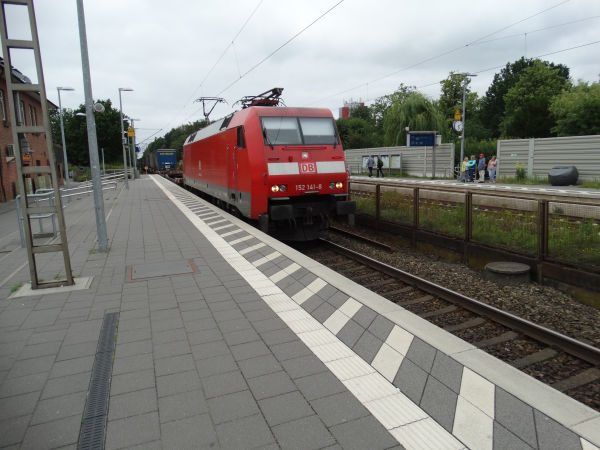
Another Br152 locomotive, here pulling an intermodal train at high speed past the small station of Tornesch north of Hamburg.
Picture from Tornesch 14.7.2019 by Ilkka Siissalo.
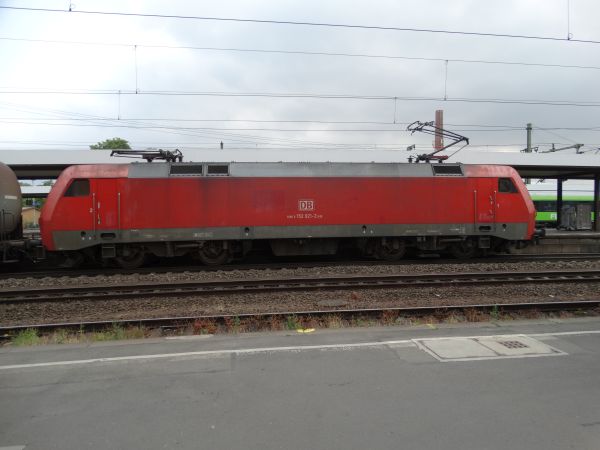
A full side view of a Siemens Br152 locomotive.
Picture from Fulda 10.7.2023 by Ilkka Siissalo.
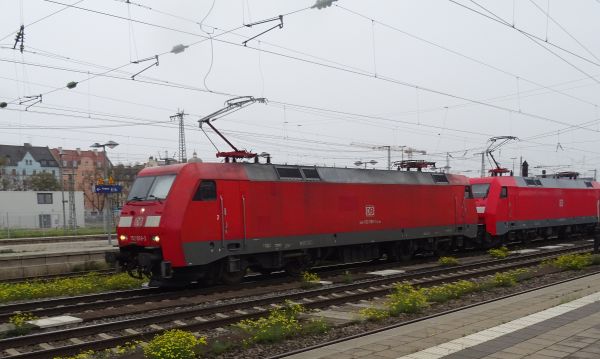
Two Br 152 machines pulling a heavy cargo train past München.
Picture from München Ostbahnhof 14.10.2022 by Ilkka Siissalo.
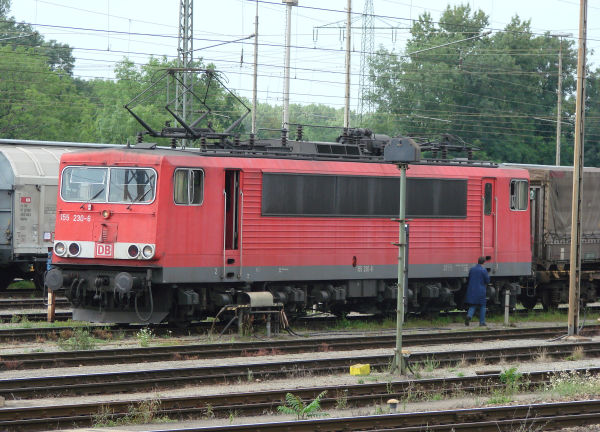
The Br 155 is a design from the communist ex-DDR. Western DB has nothing similar. It is a six axle powerful cargo locomotive. In DDR
it was called class 250, but it was renamed to 155 after the reunification of the two states. A total of 273 of them were built by LEW
Hennigsdorf 1974-1984. They were designed as universal locomotives for both cargo and passenger traffic, but later all were assigned to the
cargo part of DB. It has a power rating of 5200 kW and a top speed of 125 km/h. Its nickname is Kraftkontainer, energy container.
Picture from Weil am Rhein 17.7.2007 by Ilkka Siissalo.
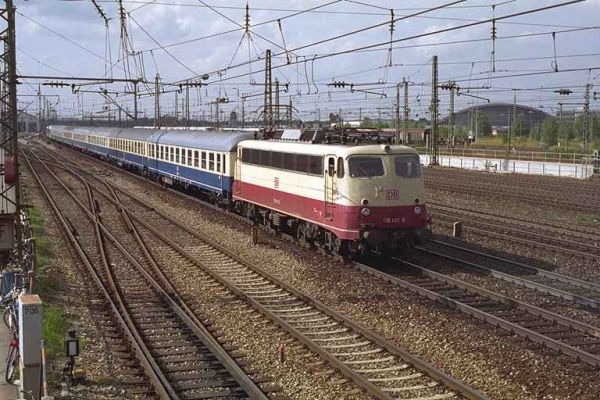
This is how the West German class 112 / E10.12 locomotives used to look like. The locomotive here is in the classic Trans-Europ-Express wine
red and creme painting just like in the early 1960s and the coaches are in the 1970s blue and creme scheme. A majority of these locomotives
had trouble with their bogies since the mid-1980s, resulting in a reclassification as class 114 with reduced speed (not to be confused with
present day class 114, a near relative to class 112 of unified Germany, and of East German origin). As the speed reduction did not help, DB
equipped the troubled locos with recycled class 110 bogies, and consequently all 20 locos of class 114 (previously West German 112) were
integrated into class 110. Class 110 no. 485 (formerly 114 485 and originally 112 485) arriving at München with a football special 23.
September 1995. Photo by Erik Hjelme.
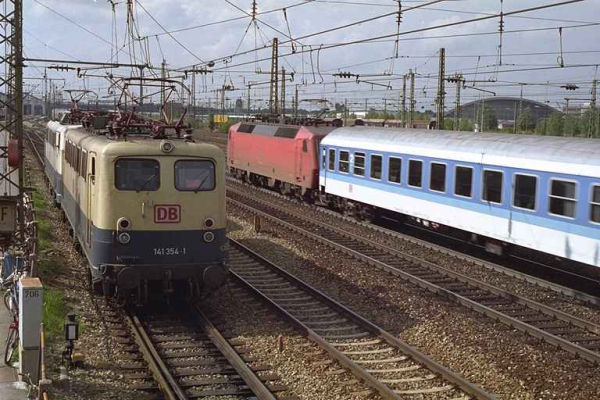
The class 141 was the regional passenger train variant of the 1950s Einheitslokomotiven family. Here seen in the 1970s blue and creme
colours, but already with the new DB AG logo. In the background a class 120 express train locomotive in the oriental red painting
scheme and with blue and white InterRegio coaches.
Original quote of the picture: 141 354-1 coming out of the depot in München. An unidentified 120
leaving with an InterRegio in the rear. 23 September 1995. Photo by Erik Hjelme.

This picture could have been from the 1970s, but it is quite not. It is a class 141 Einheitslokomotive with "Silberling" coaches
still in their metal colours like they were when they were new. This was a short haul regional service ready to leave from the station
of Hannover. Sorry for the poor quality of the picture, but the photo was taken with a small film camera, printed on paper and then
scanned with a hand scanner. Picture at Hannover Hauptbahnhof 19.8.1996 by Ilkka Siissalo.

One former East German cargo locomotive of the class 155 and four West German Br140 machines, all waiting to be scrapped.
Picture from DB depot Haltingen 3.2.2002 by Ilkka Siissalo.

The class 181 (originally E 310) and a very similar class 184 (E 410) were an early attempt to create a locomotive that would be able
to cross borders and operate on multiple electric systems. 181 was a dual system locomotive for operation in Germany, Austria, France
and Luxembourg and the 184 was an attempt at a four system variant. The four system project was quickly abandoned, and class 184 operated
for the greatest part of its career until 2001 capable for two systems only. Technology was not ripe enough. But Br 181 was used a long
time, especially in traffic from Germany to Luxembourg. Services to Luxembourg ended in 2014, and the last locos were taken out of service
in December 2018.
The first ones of these were built since 1966 and these serial locomotives of the class Br 181.2xx are from 1974-75. Here a Br 181.2xx
locomotive is waiting at the Luxembourg main station with a German InterCity train to Frankfurt.
This all is history by now and there are no longer loco hauled IC trains between LUX and DE, but just regional express trains and one
daily InterCity service operated by a Stadler KISS EMU from Luxembourg.
Picture from Luxembourg main station 19.7.2010 by Ilkka Siissalo.
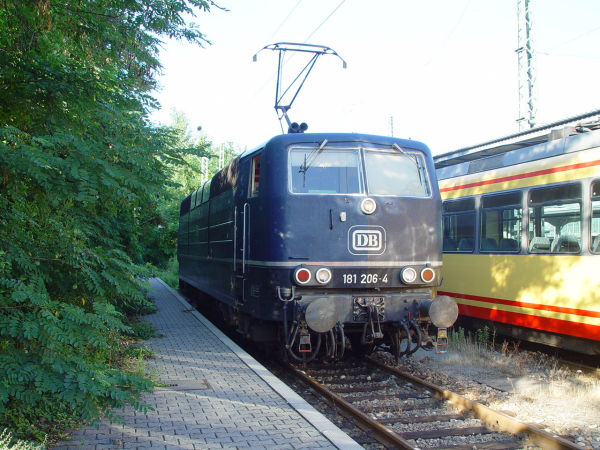
When the first class 181 locomotives were new in 1974-75, they were painted cobolt blue. Three locomotives were deliberately kept in the
original livery. This is one of them, owned by the DB Museum in Koblenz-Lützel. Picture in Karlsruhe 20.7.2004 by Ilkka Siissalo.
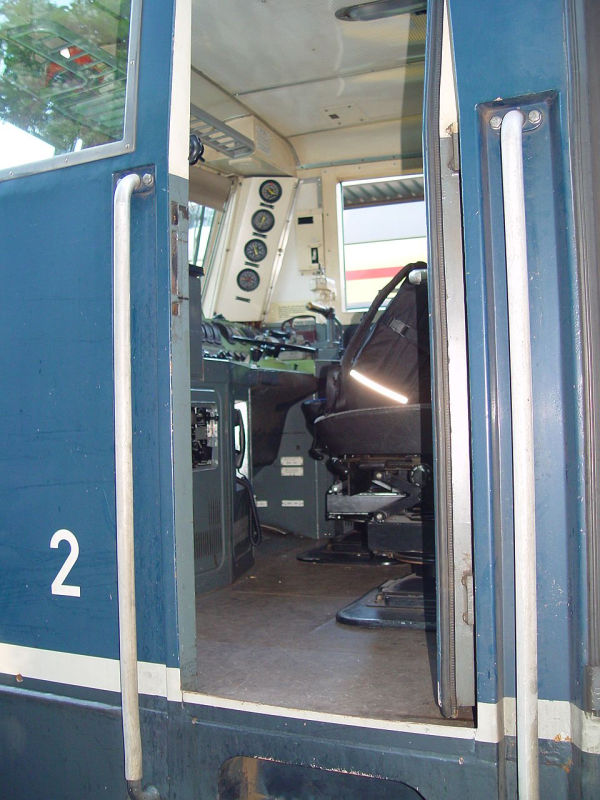
A sneak peek into the driver's cab of the Br 181 no.206. It is 1970s technology, but it looks fairly modern.
Picture from Karlsruhe 20.7.2004 by Ilkka Siissalo.
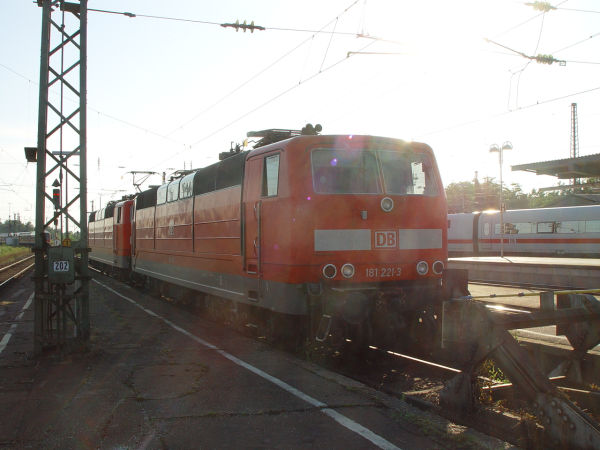
Two of the Br 181.2xx locomotives. Note that these machines have windows instead of air fan grilles at the centres of their sides.
Compare with the picture of 181 214 taken in Luxembourg, shown above.
Picture from Karlsruhe 20.7.2004 by Ilkka Siissalo.
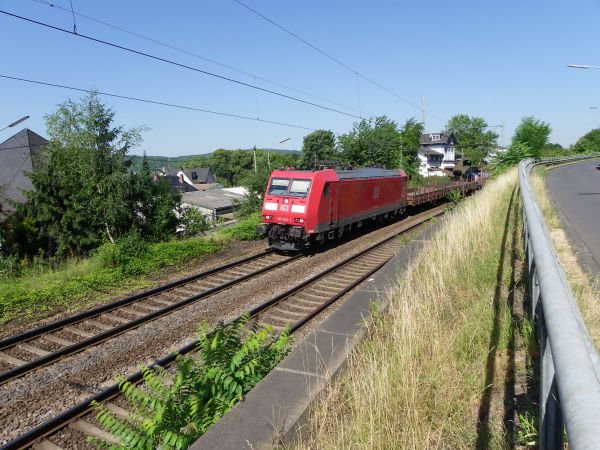
Class 185 is the multiple electric systems capable cargo version of the Bombardier TRAXX family of locomotives and this is one
of the very first Br 185 TRAXXes of DB, class 185.0xx. At later models one can see up to four pantographs and a lot more equipment on the roof.
Picture from Erpel 8.7.2010 by Ilkka Siissalo.
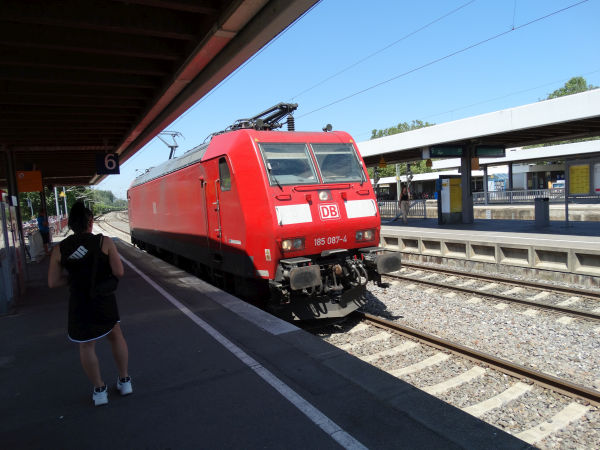
Another multiple electric system TRAXX locomotive of the very first series 185.0xx passing the station of Radolfzell at very high speed all alone.
Note the four pantographs on the roof. Even newer TRAXX machines of the subtypes 185.200, 185.300 would have a very slightly differently shaped
front. The picture is surprisingly sharp even though the locomotive must have passed here at a speed of at least 120 km/h.
Picture from Radolfzell 4.7.2019 by Ilkka Siissalo.
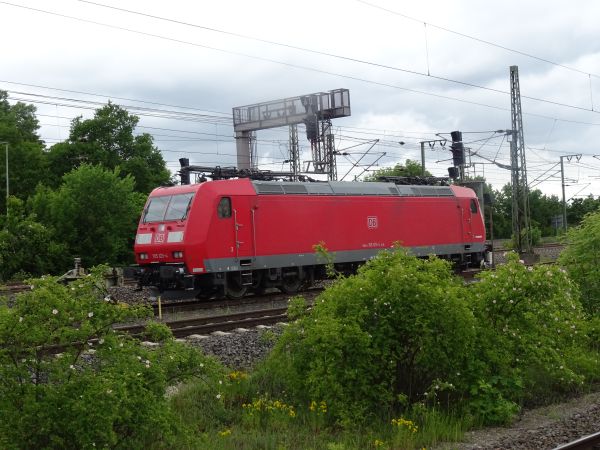
This individual locomotive 185.129 is already from the TRAXX Br185.100. It's fitted with multiple electric systems and four pantographs, but does not yet
have the improved more crash-proof front of the newer TRAXX machines.
Picture from Göttingen 30.5.2022 by Ilkka Siissalo.
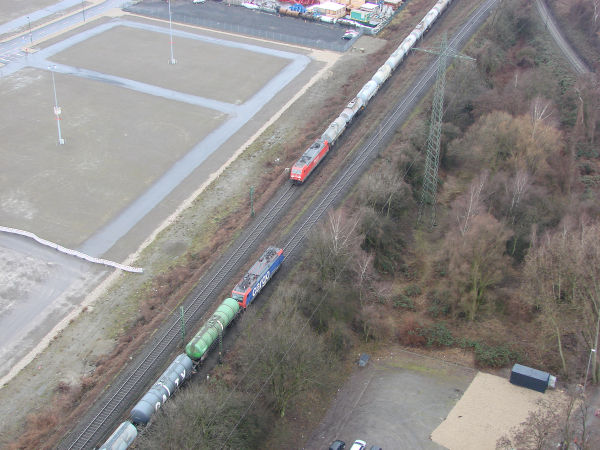
Two TRAXXes are meeting. The one on the top is a Railion (DB Cargo) TRAXX of Br 185.3xx which can run all the way up to Sweden. The blue
and red is a Swiss SBB Re482 of the TRAXX family, which can run on the DC current in Holland or Belgium, on the 25kV AC on modern Holland
to Germany lines as well as on the 15kV AC common in Germany and Switzerland. Click on the picture to see it in full scale and compare
the structures on the roofs.
Picture from the top of a huge gas container at Oberhausen 27.2.2010 by Ilkka Siissalo.
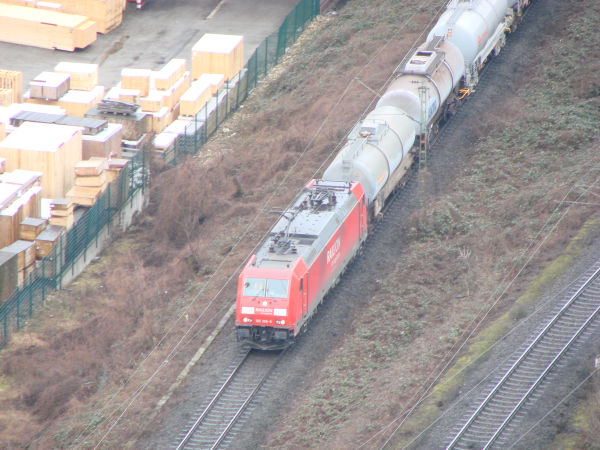
The same Railion TRAXX Br185.3xx as in the picture above, but seen from closer by.
Picture from the top of a huge gas container at Oberhausen 27.2.2010 by Ilkka Siissalo.
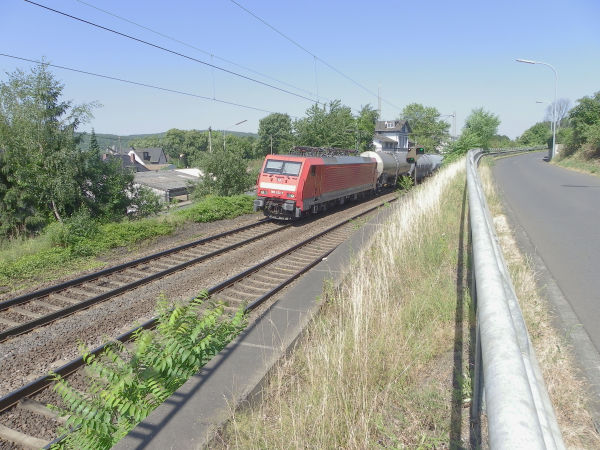
Baureihe 189 is the Siemens EuroSprinter locomotive family equivalent to the Bombardier TRAXX family's Br 185. The front looks very much
like the older Br 152 - and also a lot like the competitor's TRAXXes. The sickled side walls distinguish this type from both the Br 152 as
well as from the Bombardier TRAXX types.
If you see the locomotive by the side, the axles of Bombardier's locomotives are also markedly in different positions from what the
Siemens EuroSprinter family locomotives have. The EuroSprinters - like this one - have much longer bogies, so the second axle is way further
towards the middle of the locomotive. Like with the TRAXX Br 185s, also these Br 189s are multiple electric system machines and typically
run not only with Swiss/German/Austrian AC 15 kV but also with 3 kV DC, 25 kV AC and other voltages such as 1,5 kV DC. They are often used
in routes from Belgium or Holland east through Germany to Poland, Czech republic, Slovenia etc, sometimes all the way to Turkey.
Picture from Erpel 8.7.2010 by Ilkka Siissalo. Compare with the TRAXX pictures above.
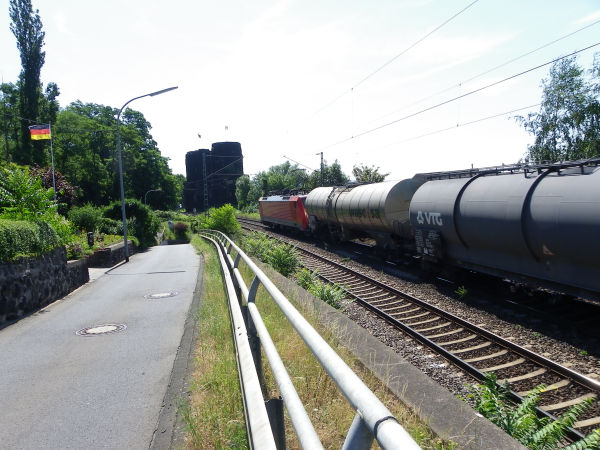
Same train as in the picture above. From this side the sickled walls of these Siemens locomotives is evident. The towers in the front
of the locomotive are remains of a famous railroad bridge, the Erpel bridge over the Rhein river. The bridge was destroyed towards the
end of WWII as US troops invaded the area and it was never rebuilt.
Picture from Erpel 8.7.2010 by Ilkka Siissalo.
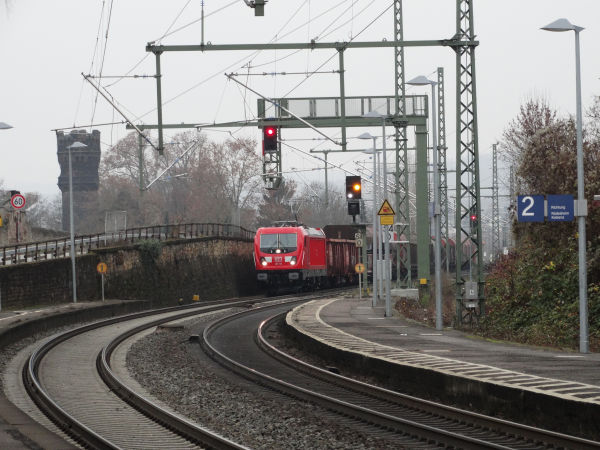
Baureihe 187 is Bombardier's 3rd generation TRAXX locomotive and at the end of 2016 the absolutely newest locomotive of DB.
As is evident from the picture, its looks have improved somewhat compared with the older TRAXXes. This is a multiple electric
system locomotive. It works both with 25 kV AC and 15 kV AC and it has also a small auxiliary diesel engine allowing it to
shunting work even without electric catenary wires. It is capable of moving a 2000 tons weighing train at 40 km/h without
electricity with this so called "last mile" diesel.
Picture from Hattenheim station by the Rhein river 16.12.2016 by Ilkka Siissalo.
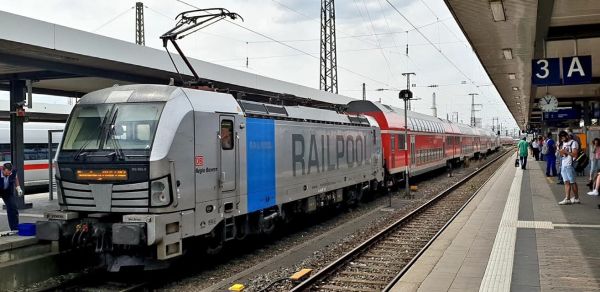
A Br193 Vectron sandwich
Right after the reunification of the two German states there arose quite understandably the demand to quickly create a fast train
connection between the former East Germany and Bayern / München. Traditional ICE trains were out of the question, because at that time
part of the line between Thüringen and Bayern was not yet electrified. DB tried to solve the issue by using diesel-powered tilting
trains of the class Br 612, which were for the purpose of making them look like "real" ICE trains painted white with a similar red
stripe that the ICE bullet trains had. But that didn't make the customers happy. Br 612 trains were designed for regional routes, meaning
that their chairs were not comportable enough for this kind of long rides. They were also too noisy. Besides people were complaining about
the line being too curvy. For a while diesel-ICEs of the type ICE-TD, known as Br605 were used. But that whole train type was soon pulled
out of use because of several technical issues, e.g. exhaust smoke being sucked in the carriages etc. Finally an accident where one of
the axles of an ICE-TD train broke causin the whole fast train to derail led to the whole series being pulled out of use.
Now for a number of years the Franken - Thüringen Express as the service is now being called, has been operated using doubledecker
coaches of DB Regio as a sandwich configuration with two rented locomotives. Here you can see the current Franken-Thüringen-Express.
There are typically two to five doubledecker coaches between the two locomotives, depending on the time and how many reservations have
been made. These rented Siemens Vectron locomotives are owned by Railpool and designated Br 193.
Picture from Nürnberg station 21.6.2018 by Risto Vormala.
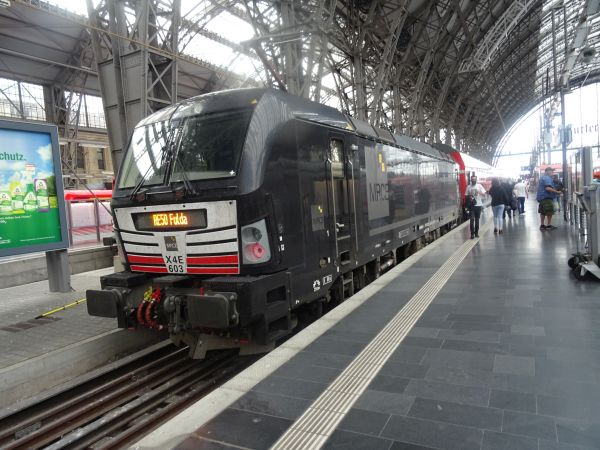
This is a very similar train compared with the Franken-Thüringen-Express shown above. In the case of the Franken-Thüringen-Express above DB
is missing the necessary new electric multiple units which would have the ETCS capabilities needed on the route and as no other ETCS
capable DB locomotives could be found, it was forced to rent suitable Vectrons. Similarly here: This is a very similar train, with two
Vectron locomotives, one at both ends, and a number of doubledecker coaches in between. But in this case the locomotives are not from
Railpool, but another leasing operator, MRCE. and the reason is not missing ETCS security devices but missing locomotives in total.
This picture is from Frankfurt and the train runs on the Frankfurt to Fulda route. There the reason for renting
locomotives is that this used to be the domain of the formerly DDR machines of the Br114 or Br112, which are so close to their end of life now
that not enough working Br112/Br114 locomotives can be found any more. This route is expected to get totally new EMU trains by the end
of 2025 and before that, the old Br114 locomotives can and must be used and whenever there are not enough of them, rented Vectrons will
have to step in.
Picture from Frankfurt am Main 3.6.2022 by Ilkka Siissalo.
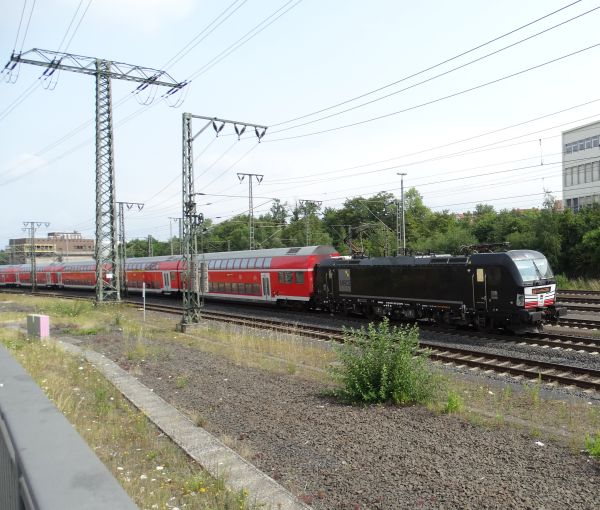
A very similar train as above, long rake of doubledecker coaches running as a regional express, having at both ends a rented Siemens Vectron
locomotive. DB has rented these locomotives from MRCE Dispolok which prefers to call its Vectrons not Br 193 like the official designation
should be but rather as type X4E.
Picture from Würzburg 10.7.2023 by Ilkka Siissalo.
Historic DB electric locomotives
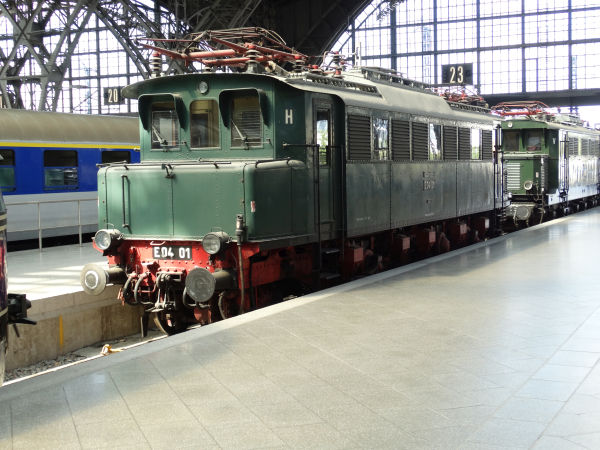
The electric locomotive type E04 is from the pre-war Nazi times. It was developed for express trains in 1932-36. The type served as
E04 during the pre-war DRG times, as Br104 of DB of West Germany and as Br204 of DR of the communist DDR. 23 machines were made and
the last one was taken out of use in 1982. This is the very first one of the series. Its maximum speed was 110 km/h and its power rating
was 2190 kW. 10 of these machines were at home at Bahnbetriebswerk Leipzig West for a very long time and now the very first one,
E04 01 is put on display at the Leipzig main station.
Picture from Leipzig Hbf 16.7.2018 by Ilkka Siissalo.
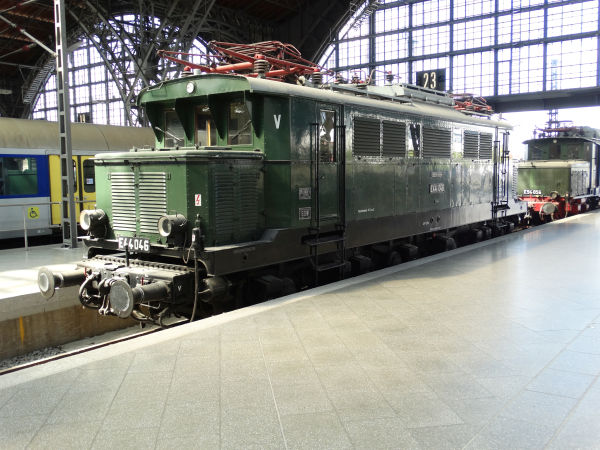
The electric locomotive type E44 is also from pre-war Nazi times. It was the first electric locomotive type of Germany which was built in
more than 100 copies and it was a very technically advanced machine at the time. The first series was built 1932-45, but more of the same
machines were built even as late as 1955. In West Germany they were known as DB Br 144 and Br 145 and in the communist east they were DR
Br 244. The last loco, a former DR loco but classed as 144 after reunification, was taken out of service in December 1994. Its top speed
is 90 km/h and it has a power rating of 2200 kW. As such it was suitable for both
passenger and cargo trains. After the war Soviet Russia confiscated many of these machines from the East zone of Germany and regauged them
to 1524 mm and used them in Perm for a while, until they were given back to DDR in 1952 in a desolate condition. In the west these machines
were used in the southern parts of the country, including Basel to Lörrach services on the Swiss border. Br 145 was a special version with
rheostatic brakes. The famous Höllentalbahn near Freiburg im Breisgau was being operated with them for a long time.
Picture from Leipzig Hbf 16.7.2018 by Ilkka Siissalo.
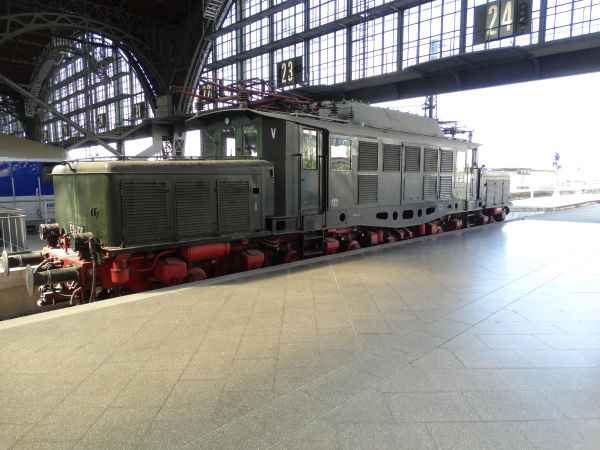
The electric locomotive type E94 is also from pre-war Nazi times. It was a heavy cargo locomotive and a very successful type. The last ones are
still in use at some private operators as this is being written in 2019. The type was known as E94 at pre-war DRG, as DB Br194 in the West,
as DR Br254 in DDR and as Br1020 in Austria. It's a six axle machine which was built in 231 copies 1940 to 1956. Its top speed is 100 km/h
and its power rating is 3303 kW. It's often referred to as the German Crocodile.
Picture from Leipzig Hbf 16.7.2018 by Ilkka Siissalo.

